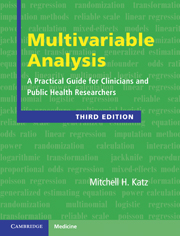Book contents
- Frontmatter
- Contents
- Preface
- 1 Introduction
- 2 Common uses of multivariable models
- 3 Outcome variables in multivariable analysis
- 4 Independent variables in multivariable analysis
- 5 Relationship of independent variables to one another
- 6 Setting up a multivariable analysis
- 7 Performing the analysis
- 8 Interpreting the results
- 9 Delving deeper: Checking the underlying assumptions of the analysis
- 10 Propensity scores
- 11 Correlated observations
- 12 Validation of models
- 13 Special topics
- 14 Publishing your study
- 15 Summary: Steps for constructing a multivariable model
- Index
- References
9 - Delving deeper: Checking the underlying assumptions of the analysis
Published online by Cambridge University Press: 01 April 2011
- Frontmatter
- Contents
- Preface
- 1 Introduction
- 2 Common uses of multivariable models
- 3 Outcome variables in multivariable analysis
- 4 Independent variables in multivariable analysis
- 5 Relationship of independent variables to one another
- 6 Setting up a multivariable analysis
- 7 Performing the analysis
- 8 Interpreting the results
- 9 Delving deeper: Checking the underlying assumptions of the analysis
- 10 Propensity scores
- 11 Correlated observations
- 12 Validation of models
- 13 Special topics
- 14 Publishing your study
- 15 Summary: Steps for constructing a multivariable model
- Index
- References
Summary
How do I know if the assumptions of my multivariable model are met?
Reader beware: keep your biostatistician near for this chapter.
In the last chapter, I covered how to assess how well your model fit your data based on those parameters that are typically output by standard computer software packages. In this chapter, we are going to delve deeper to check the underlying assumptions of the models and to determine strategies for improving the fit of models. Reader beware: keep your biostatistician near for this chapter. Not only are some of the concepts hard, but many of these supplementary procedures require judgment that comes from having done many prior analyses. Also for many of the issues described below there is controversy as to what procedures are best and whether some have value at all.
The content of this chapter is often referred to as regression diagnostics (as in diagnosing problems with regression models). One of the most useful tools for assessing whether there are problems with the model is analysis of residuals, the subject of the next section. In that section I will review how you can use residuals to assess the overall fit of multivariable models. In the subsequent section I will review how to use residuals and other techniques to identify departures from specific assumptions of multivariable models.
- Type
- Chapter
- Information
- Multivariable AnalysisA Practical Guide for Clinicians and Public Health Researchers, pp. 162 - 179Publisher: Cambridge University PressPrint publication year: 2011



